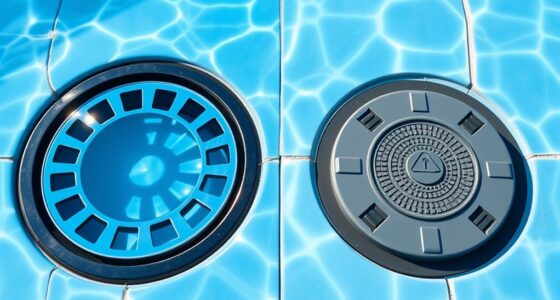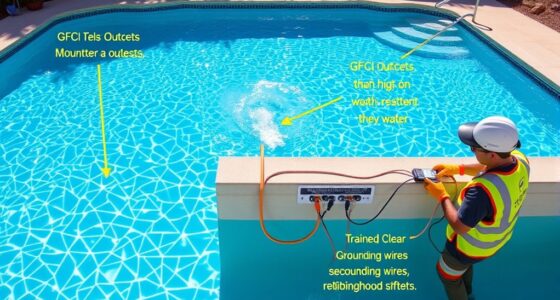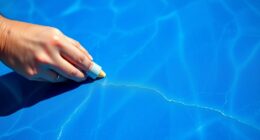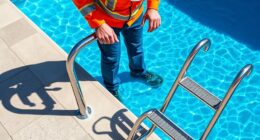To understand Virginia Graeme Baker Pool and Spa Safety Act compliance, you need to focus on installing and maintaining safety barriers, like fences with self-closing, self-latching gates at least four feet high, to prevent unsupervised child access. You must also make certain your drainage systems have anti-entrapment devices and are regularly inspected for proper function. Following signage and safety protocols is key, and there’s more to learn about making your pool safer and compliant.
Key Takeaways
- Ensure pool and spa drains comply with the Virginia Graeme Baker Act, including anti-entrapment drain covers and fittings.
- Install safety barriers such as fences at least four feet high with self-closing, self-latching gates.
- Conduct regular inspections and maintenance of drainage systems and safety equipment for proper functioning.
- Use approved anti-entrapment devices like safety covers and anti-vortex fittings to prevent dangerous suction forces.
- Display clear signage and enforce supervision to educate users on safety protocols and prevent accidents.

Ensuring your pool or spa complies with the Pool and Spa Safety Act is essential for protecting everyone who uses it. This federal law aims to prevent accidents and drownings by establishing clear safety requirements. As a responsible pool owner, you need to prioritize child safety and adhere to equipment standards to create a secure environment. Kids are naturally curious, and without proper safeguards, they can easily access the water and face serious risks. Implementing effective barriers, such as fences with self-closing, self-latching gates, is a critical step toward preventing unsupervised access. These barriers should be at least four feet high and designed to be child-resistant, ensuring that children cannot climb over or open them easily. Additionally, incorporating gears and mechanical elements into pool safety equipment can enhance the robustness of safety features, aligning with the mechanical themes found in steampunk and Victoriana designs.
Beyond barriers, the equipment standards set by the Act play a crucial role in safety. Pool and spa drains must be compliant with the Virginia Graeme Baker Pool and Spa Safety Act, which mandates the use of anti-entrapment devices such as safety covers, drain covers, and anti-vortex fittings. These devices prevent powerful suction that could trap a swimmer, especially children who are more vulnerable to such hazards. You should regularly inspect your drainage systems to ensure they meet the required standards, replacing any damaged or outdated equipment immediately. Proper installation and maintenance are key to making sure these safety features work effectively.
Furthermore, your responsibility extends to educating everyone who uses your pool or spa about safety protocols. Children should be supervised at all times, and they need to understand the dangers of the water. Simple rules, like no running around the pool area or diving in shallow water, can greatly reduce accidents. Signage that reminds users of safety measures is also recommended, especially if you have guests or children visiting frequently.
Frequently Asked Questions
How Often Should Pool Safety Equipment Be Inspected?
You should inspect your pool safety equipment weekly to guarantee everything works properly. Regular checks include verifying lifeguard certification status and making sure pool safety signage is clear and visible. Also, inspect safety devices like rescue hooks and alarms for damage or malfunction. Consistent inspections help maintain compliance with safety standards, prevent accidents, and ensure a safe environment for swimmers. Always document inspections to stay prepared for any safety audits or emergencies.
Are There Penalties for Non-Compliance With the Act?
Yes, there are enforcement penalties and fines for violations of the Virginia Graeme Baker Pool and Spa Safety Act. If you don’t comply, authorities can impose significant fines and other enforcement actions. You’re responsible for maintaining safety standards, and neglecting these can lead to costly penalties. Stay proactive by ensuring your pool equipment meets all safety requirements, so you avoid fines for violations and help keep swimmers safe.
What Training Is Required for Pool Staff?
You need to guarantee your pool staff has lifeguard certification and emergency response training. This training prepares them to prevent accidents and respond effectively if an emergency occurs, complying with the Virginia Graeme Baker Act. Regular refresher courses are also recommended to keep skills sharp. Proper training not only meets legal requirements but also keeps swimmers safe, giving you peace of mind.
Can Older Pools Be Retrofitted for Compliance?
Did you know that over 70% of older pools can be successfully retrofitted for compliance? You can upgrade your pool by installing new drain covers that meet current standards and enhance pool cover safety. Retrofitting is often cost-effective and straightforward, allowing you to improve safety without complete reconstruction. By ensuring your pool adheres to drain cover standards, you protect swimmers and stay compliant with safety regulations.
How Does the Act Impact Small or Private Pools?
The Virginia Graeme Baker Pool and Spa Safety Act markedly impacts your small or private pool by enforcing private pool regulations that require specific safety measures. You’ll need to guarantee drain covers meet safety standards, which might mean upgrading existing equipment. While DIY safety measures are helpful, it’s recommended to consult professionals for proper installation and compliance. Staying informed on these regulations helps keep your private pool safe and within legal requirements.
Conclusion
By staying informed about the Virginia Graeme Baker Pool and Spa Safety Act, you might just find yourself preventing a tragedy when you least expect it. Sometimes, a simple safety measure can make all the difference, turning a routine day into a life-saving moment. So, as you check your pool’s compliance, remember—what you do today could unexpectedly save a life tomorrow. Stay vigilant, stay safe, and keep your loved ones protected.









